#yes I’ve seen a Rothko in PERSON and seen the scale of it
Text
Anti Intellectualism in art is bad and garbage and saying “my kid could make that” is annoying and just flat out wrong blah blah blah but what the FUCK am I supposed to feel when looking at a Rothko?? Is this a joke??? Am I being pranked?? Like I am TRYING to understand please dear god tell me I’m missing something and it’s not just,.,,, that?
#yes I’ve studied art history#yes I know color theory#yes I’ve seen a Rothko in PERSON and seen the scale of it#it was just as unimpressive there too#pls tell me I’m missing something#no matter how many times it’s explained to me I just don’t get it???#I wouldn’t DARE criticize Malevich bc I know the historical significance of his work#but like#ok look I know he’s super influential#and one of my fav profs LOVES Malevich…. but like#black square???#idk idk this class will be the death of me#Ive watched like five different abstract art documentaries today to try and understand it and it’s not clicking
1 note
·
View note
Text
Museum Series: Tate Modern
The Tate Modern in London is surely well-known even outside the art world. It’s probably more famous for its building though, an old power station transformed into a contemporary art showroom, with enormous interiors like the Turbine Hall right in the center of it all.
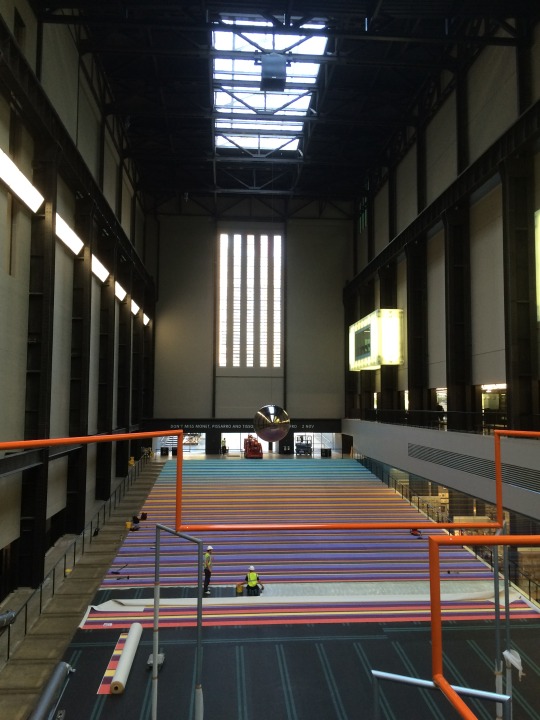
The Turbine Hall. It is a huge space, just look at the size of the two men in helmets in comparison to the sheer volume of the space! Installation of an artwork was going on when I visited the place, and it’s only after I’ve returned to Singapore that I saw the artwork was now open. It’s titled One Two Three Swing! and it’s a commission by Hyundai, created by a group of artists known as SUPERFLEX. Though I didn’t get to experience being a part of such a relational art, it was still interesting to see them installing it because usually when a part of a museum has installation going on, it is all sealed up from the public. But in the Turbine Hall, maybe there was just no way to seal it up given its size and central location, so the process of installation is open for all to see! In my opinion.. That’s also a part of “giving art back to the public”, as they’re now making what is supposedly a “restricted” or “private” process open to the public.

Another view of the great Turbine Hall, this time from one of the gallery windows. See how the scale (the large large columns and beams) simply dwarfs everything in its surroundings! And this is another great view of installation going on in the museum. Imagine when everything is done and set up, one is able to see great artworks from this little corner of one of the galleries. That’s quite neat!
One of the things I really liked during my visit is how they curated the permanent exhibition galleries, and how that information is clearly presented to visitors in museum map:
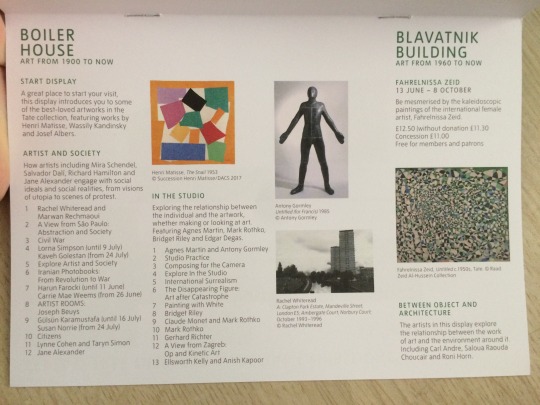
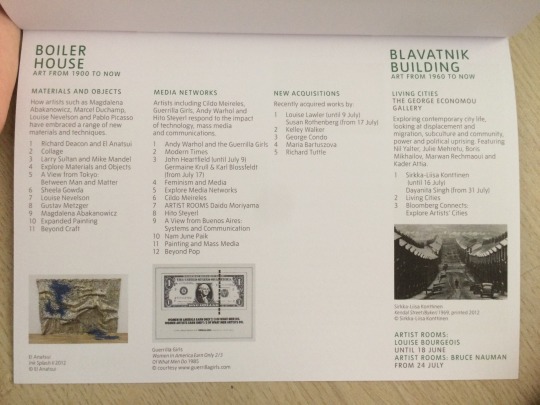
Different themes in art are dealt with on different levels and buildings, and each theme and every single gallery space are clearly listed in this info brochure, so one always know what one is looking at, and how it relates to the world or art world as a whole. Themes like Artist and Society, In the Studio, and Material and Objects are educational and probably came from the perspective of a curator, and while some might argue that they prefer not to see art filtered through the lens of a curator because it is inevitably rooted in all sorts of bias, I quite appreciate this type of organization. While a chronological order might sometimes be better, I think there’s not much harm trying to put these modern and varied works of art under different themes, and might even be better if these themes change once in a while, just so not one viewpoint is always dominating and being conveyed.
Anyway, enough of my art theory ramblings and here is finally a work of art proper.
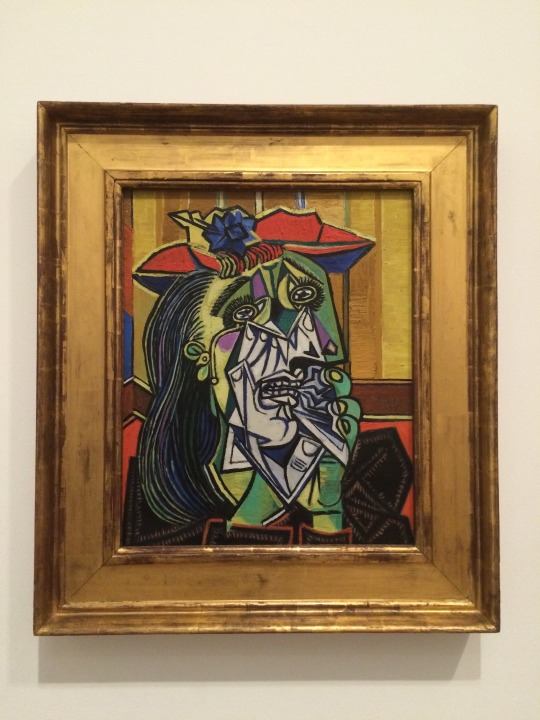
The Weeping Woman by Picasso.
Why is it significant? From the art history point of view, it was a response to the Spanish Civil War, specifically the massacre caused by “the bombing of the Basque town of Guernica by the German air force” (quotes blurb). Before this painting, Picasso had painted the well-known mural Guernica, and this woman is “based on one of the figures in the mural” and in the mural, she was holding her dead child. Also might be of interest, is that her “features are based on Picasso’s lover”. (Yes I realize how little I know about specific paintings now, now that I have to quote blurbs to help me..)
From the aesthetic point of view, this is a really great Cubist painting! How all the forms, angularity, contrast in forms, contrast in colors come together to make such an aesthetically pleasing image, even though it’s really horror that I think it’s meant to convey.. But personally, it’s quite significant because this painting appeared in one of our first art criticism tests! And I remember till this day, that the question was something like, Compare and contrast how the subject matter is dealt with in “The Weeping Woman” by Picasso and “Migrant Mother” by Dorothea Lange. WOW. I can hardly believe that question was for new students in art history.. because it seems like this question can warrant an answer the length of a paper... But anyway, here is Migrant Mother:

Maybe you can take a shot at comparing the two, if, you know, you have nothing better to do at this moment.
Besides “The Weeping Woman”, there are many other famous artworks in Tate Modern, like Warhol’s screeprints “Marilyn Diptych” and “Mao Tse-Tung”, Claude Monet’s waterlilies, Dali’s “Lobster Telephone”, Magritte’s “Man with a Newspaper”, and a room full of Beuys’ “information action” documentation. There’s also a room full of Mark Rothko paintings, and also a copy of Duchamp’s “Fountain”.
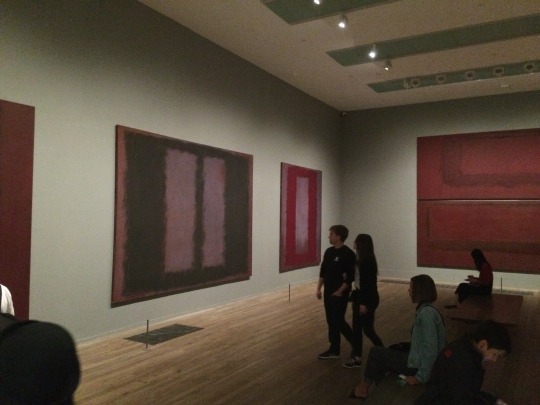
This is the room full of Mark Rothko paintings. It is interesting because two days later, while sitting at the cafe in my hostel, a Canadian man came up to me and we started chatting and among the things we talked about, was this room full of Mark Rothko paintings. When I was there, apart from noticing a girl writing notes in front of one of the paintings and wondering what can she be possibly writing as she looks up and down between the painting and her notebook, I didn’t have much emotional response to this room full of Mark Rothko paintings. But the man whom I met, apparently he had also gone to the Tate Modern in the past few days and apparently he had also come into this room full of Mark Rothko paintings. And he told me just how depressing he thought they were! We had a really interesting long chat after that, and this guy was quite a character to remember now that I am seeing Mark Rothkos!
Amidst all these artwork, I found one that I liked, really liked. I had blogged about it previously and it’s called “How Not To Be Seen” by Hito Steyerl.

How Not To Be Seen: Lesson 1: How to make something invisible for a camera. The artist presents four lessons in her video, all in an ironical didactic manner. It’s a really funny and great piece of social criticism in my opinion, and if you haven’t seen the artwork or read my post, here is the link: https://settings-airplane-mode.tumblr.com/post/165868048700/day-44-how-not-to-be-seen. And it has become my favorite piece of video art ever since! Just check it out, it’s really, really funny, especially if you’re in architecture, or interior design, or landscape design, or just do architectural renderings in general. Trust me, there’s gonna be a bit of surprise for those of you making renderings!
And apart from just seeing art, being the interior design student that I am, of course it is routine to check out the building itself too, no? Well, on the outside, it’s all brick-clad and pretty industrial. But on the inside, I found out a very Brutalist side of it. The interior walls and columns were exposed concrete, and especially the open space next to the Turbine Hall on the ground floor (The Tanks), it’s all very.. Brutalist. So Brutalist that I really just wanted to get out of that place as soon as possible, instead of searching for the free exhibitions that were indicated by the maps. Is that how Brutalist architecture is meant to make us feel??? I haven’t looked into that topic...
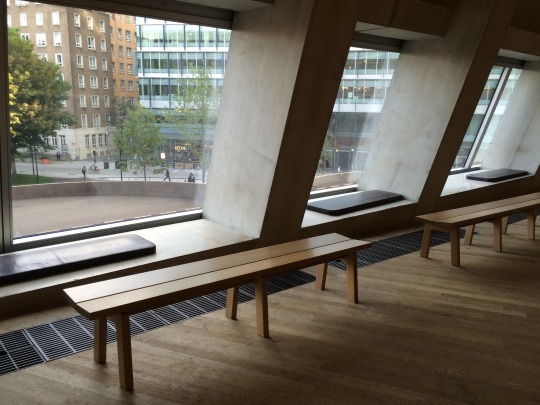
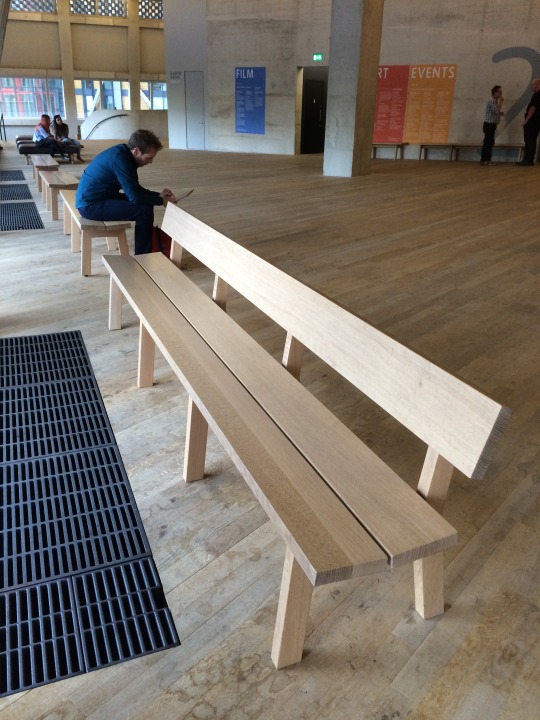
And finally here are some beautiful benches (and thoughtful seating pads) along one of the facades! Great natural lighting there, it really seems to counter the disquieting effects of the Brutalist architecture...
And that’s all I have for now, on Tate Modern!
#tate modern#turbine hall#superflex#london#art#travel#writing#museumseries#brutalist#architecture#interior design#art criticism#picasso#weeping woman#hito steyerl#fine art#modern art#contemporary art
0 notes